Pole, Line, & Freedom
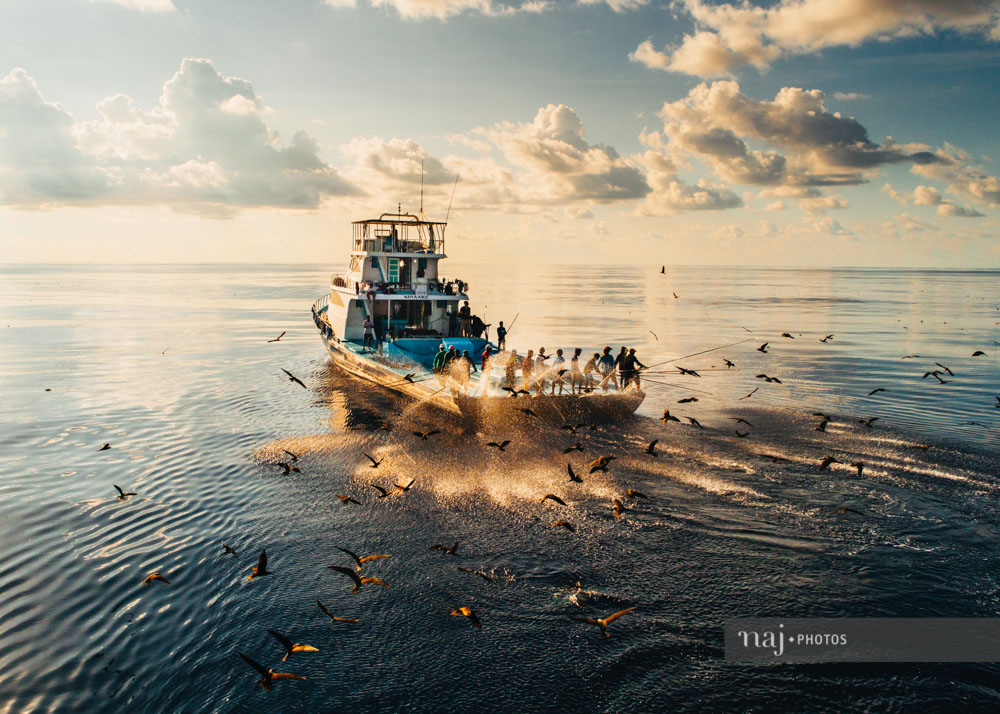
Words by Daniel Bosley; Images by Aishath Naj
From time immemorial, fishing has been described as the ‘lifeblood of the Maldives’: a symbol of freedom, autonomy, and sustenance. While cowry shells set traders’ pulses racing well into the 19th century, coir rope and copra kept business flowing, and the adrenaline of tourism has turbo-charged the economy for the past fifty years, mas beynun has never missed a beat.
Everything surrounding the Maldivian fisherman may have changed; from sail-powered dhonis to diesel-powered cruisers, stars and the nakaiy to satellite navigation, from ragged mundu(s) to Real Madrid jerseys. But, when the captain calls out and the fish start to frenzy, such details are relevant to neither time nor tuna.
In close competition with the humble coconut, it’s this creature that has made life possible in the isolated atolls for the past two thousand (plus) years. This ‘foolish fish’ – as described by Francois Pyrard 400 years ago – is easily tricked into taking a bait-less hook, while it’s firm flesh is well-suited to be smoked, dried and converted into what was once the country’s de facto currency. Indeed, less than a decade before resorts began hooking tourists (and dollars), the famous ‘Maldive Fish’ was described by the UNDP as the main form of foreign exchange, representing 90% of all exports.
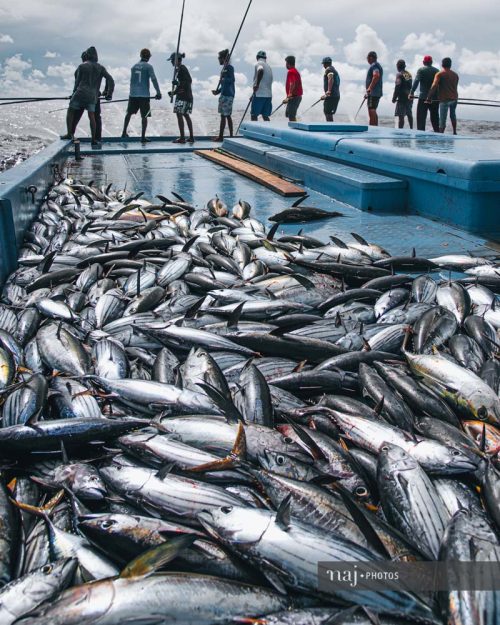
Today, tourists having overtaken tuna as the main source of income, contributing more than half of GDP (the fourth highest anywhere in the world, says the World Travel and Tourism Council). But while the Maldives imports two million holiday-makers a year, fish (and sunburn) remain the only significant outgoings. Of the one million tonnes of tuna caught in the Indian Ocean every year, around 15% is still caught by Maldivians (that was 150,000 tonnes in 2018).
Here’s how it’s done…
First…
Before that famous photogenic moment, when a dozen masveriya begin to fling surprised fish over their shoulders onto the broad open deck, there must be bait. And before bait, there must be boat.
Even the earliest visitors to the Maldives found that local vessels were highly sophisticated; no dugout canoes or outriggers here, perhaps due to the relative lack of larger trees. The most notable feature for early observers were the ‘sewn boats’, with planks lashed together by coir rope, and not a metal nail in sight. While the sewn boats went out of style many centuries ago, the basics of the mas dhoni remained unchanged for millennia. As recently as the 1970s, visitors could expect to see a dozen fishermen sailing, rowing, or even dragging their wooden dhonis – up to 12 metres in length – out over the reef to pre-dawn cries of the koveli.
The first mechanised boat arrived in 1974, and the revolution of the fleet was largely complete by the late ’80s. Today, comparatively huge craft chug through channels blasted in the reef. Fishermen who might previously have made offerings at a local ziyaaraiy, asking for fair winds and calm seas, now hope only that fuel prices stay low. Regardless of all these developments, however, a hard day’s work still begins inside the atoll lagoons.
The main target of Maldivian fishing is the skipjack, but it’s the baitfish – sprats, anchovy, cardinal fish, and dozens more – who perform the under-rated role of middlemas. The country’s famously sustainable pole and line method requires live bait, and collecting bait can still take up half of a dhoni’s day. So crucial have these under-rated actors been in the Maldivian story, some analysis of island names suggests certain islands may have been populated primarily due to their access to regular bait supplies. While tuna may be foolish, baitfish can be fickle, and seasonal fluctuations have combined with breakneck development to leave a general confusion as to the overall health of local stocks.
(Hover over images to scroll through)
In Addu atoll, for example, fisherman complain of long-term shortages – some blaming local infrastructure projects – and normally journey 60 miles north, to Huvadhoo atoll, to get bait. Experts wonder about the impact the industry’s rapid recent expansion might have on stocks, but attempts at systematic monitoring began only a decade ago. Among other things, these studies have revealed that Maldivian fisherman use bait less efficiently than almost anyone else – a rough average of 7-12kg of tuna for every kg of bait, versus 10-22kg caught elsewhere; although this may say as much about the traditional abundance of bait stocks as it does about future sustainability. Studies suggest that 15,000 tonnes of bait is used each year, a figure that closely matches the estimated maximum amount local stocks can sustainably tolerate.
Catching bait, in many ways, requires as much skill as flinging tuna, and certainly more teamwork. Traditional methods often involved herding passing shoals, beating the the shallow shoreline with palm branches toward the waiting nets of fellow islanders. While this method can still be spotted on occasion, today the vast majority of bait is caught in the deeper lagoon, with large lift-nets sunk up to 60 metres to the atoll floor before being drawn up to ensnare schools passing overhead. For countless centuries, this method required long poles, a little fish paste or crab meat (bait for bait), and sustainable levels of patience. Modern developments, however, have seen the introduction of scuba gear, and in the 1990s, the widespread use of industrial lights. Ninety percent of bait collection is now thought to take place at night.
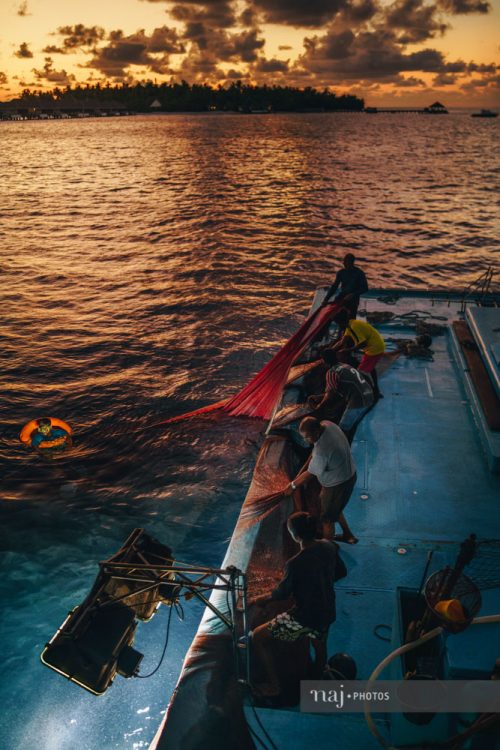
Once caught, the live bait can only be kept that way by keeping water circulating within the boat. Previously, this would be achieved by the precarious method of allowing seawater into the hull, via open plugs opposite the mast. Meanwhile, essential workers would be tasked with bailing furiously from the other end, using hollowed coconut shells. Today, mechanisation means that pumps ensure circulation within bespoke bait tanks, though the mortality rate of the most readily-available species persists, who survive little more than a day on board.
Fish!!
The longevity of these little helpers – even in well-circulated holds – was less of an issue in times past, when these semi-sunken ships would creep out just a few miles distance from the atoll, fishing until sunset, before sailing safely home. Without having to worry about traversing the reef after dark, today’s high-tech dhonis can venture further and stay out longer, vastly expanding the fishing grounds accessible.
Fish aggregation devices – essentially large buoys located throughout the Maldives’ territorial waters – have become a familiar part of the otherwise featureless Indian Ocean-scape in recent years; but Maldivians have never used nets for the big game. While foreign fleets in surrounding waters (barred from the Maldives’ EEZ) employ purse-seining – drawing out huge nets, and drawing in large amounts of by-catch – mas dhonis have stayed true to their craft. After all, Victorian researchers were assured, the tuna would surely be able to see the nets through the Maldives crystal clear waters (there were also initial concerns that motorised boats would scare away the fish).
No, it seems that neither duration, distance, nor modern devices – neither time nor space – can sway a fisherman firmly fixed in his ways. When a school of tuna is spied – be it via a telltale circle of seabirds, or the churning of fins somewhere along the horizon – the same method has sustained Dhivehi Raajje back beyond recorded history: one man, one fish, one pole and one line.
(Hover over images to scroll through)
When the shoal is spotted, the crew – armed with 20ft of fibre-glass and nylon (having replaced wood and jute) – line up across the rear of the boat; a grizzled chorus-line, finally standing centre stage, facing an unwitting audience, about to take an involuntary backstage tour. Further back, beside the bait tanks, other crew members toss out handfuls of rehi, miyaran, and handali to the crowd, while steady jets of water leave the stupefied skipjack unsure as to what is food, what is phantom, and what is fatal. A well-timed flick of the wrist and the first tuna is airborne, landing with a sliding thud across the slick deck. Within moments, dozens more have accepted the invitation, though their hosts never glance back. The show must go on.
The heavy bodies begin to pile up; some make it as far as the protective netting shielding the front end of the boat, signifying another score; perhaps one fortunate fish in a hundred might bounce up and out of the boat again (albeit probably to head straight back into the melee for another round). The rest are littered in thrashing silver spasms across the hollow hold, sounding like a dozen generators sputtering into (or out of) life, before another crew member rushes over, wielding a concluding wooden club.
Fresh…
When the bloody battle is over, and the timeless mist of spray clears. Lurid pink foam is hosed from the decks – an essential chore once considered vital to keep away ancient sea-spirits – and the hatches are opened. While some are empty, awaiting the new arrivals, another contains the modern miracle that has altered the industry as much as any form of mechanisation: ice.
As well as the fear of being lost at sea (or, awkwardly, found by the reef in the dark) fishing trips were previously curtailed by the need to get the tuna back to the boiling pots, smoking sheds, and drying racks back home. Once processed in this manner, usually by island women who were not permitted to join the crew, ‘Maldives Fish’ could keep for months, forming the hard and hiki foundation of the islands’ subsistence economy. Once home, the catch was divided up according to a well-established hierarchy – from owner and captain, down to the cook and the ever-essential balers – with even the island katheeb and fandithaveriya taking a cut.
Once the shares were distributed, smoked and dried, the fish would then be purchased by local merchants, sold to the government trading corporation in Male’, then the Ceylonese government, and finally to local consumers; who’d pay up to five times the original island price. For the best part of a century before the UNDP’s visit, the trade had been monopolised by Gujarati Borah merchants who – with the benefit of knowing the price for both Maldive fish and for rice in Ceylon – dominated the market. British traveller T.W. Hockly reported that fish exports had risen 1,500% between the merchants’ permanent settlement in Male’ and his visit in the 1930s.
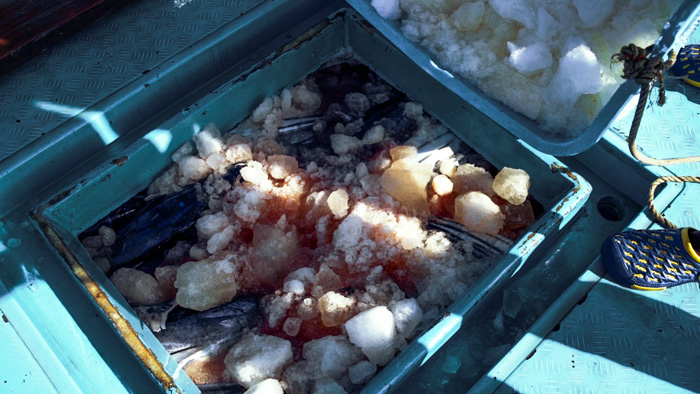
A generation later, just as tourists were arriving to provide the base for future wealth, Japanese investors were also expressing an interest in purchasing fresh tuna. Refrigerated vessels appeared in the atolls in the early 1970s, with canneries following, and modern ice plants are now able to supply boats with enough ice to keep their catch fresh on board for days. Very little of the fish caught today ever see the inhabited islands, with just the smallest experiencing the traditional island treatment; those rejected by the Maldives Industrial Fishing Corporation (MIFCO), the state-owned company whose refrigerated vessels and island factories succeeded the first Japanese boats.
As well as severely altering the traditional role of women in island life, this change is also thought to have reduced the amount of fresh fish eaten in the atolls. Nevertheless, reports still suggest Maldivians eat more fish per capita than almost anyone else on earth (vying for the number one spot with the Icelandic).
Future
After sustaining the nation for longer than history can say, traditional fishing has fallen out of fashion in recent decades, even as the industry’s modernisation has brought record hauls. The 1921 census reported that 14,760 men were dependent on fishing for their livelihood; in 2017, however, despite the overall population having more than quadrupled, the number of fishermen has swelled by less than 20%. The diversification of the Dhivehi economy now sees most people employed in civil- or in customer-services. Surprisingly, however, salaries in government offices and on resorts are less lucrative than those on the dhonis: Maldivian fishermen earn an average of $1,500 a month, while the government still pushes for a $415 minimum wage elsewhere.
(Hover over images to scroll through)
Indeed, the Maldives fishing industry is renowned for being comparatively labour-friendly, in a global industry notorious for it’s horrendous working conditions. But elsewhere jobs are more reliable, more comfortable, and safer; there’s far less chance of catching a hook in the eye by the buffet, or being asked to plunge to dangerous depths for stationery. So, despite the historical debt owed to the industry, most young Maldivians no longer see fishing in their futures.
For those that do, the picture is still uncertain. Declining catch numbers in the mid-noughties soon recovered but more thorough management of the $30 billion global tuna business – in which catches have increased by 1000% since 1950 – will be essential if growth is to be sustained. The Maldives skipjack tuna fishery is one of only two operating in the region certified with the Marine Stewardship Council’s eco-label, although certification for pole & line Yellowfin tuna was suspended in 2016 due to the wider region’s dwindling stocks.
(Hover over images to scroll through)
Meanwhile, the creeping spectre of climate crisis continues to cast suffocating shadows on the rising horizon. Research indicates that warming oceans will force tuna deeper and eventually away from the Maldives’ equatorial waters over the coming decades; out of reach of pole, line or most mas dhoni. These anticipated migrations are forecast to precede an eventual collapse in species biomass as the oceans continue to soak up trapped heat and carbon.
More immediately, the Covid crisis of 2020 has reminded many of the fragile nature of a tourism industry dangerously exposed to external shocks. As resorts closed down and flights were grounded, many of the newly-unemployed began heading toward island harbours, hoping for more something a little closer to a sustainable livelihood; something a little more sovereign, a little more…‘lifeblood’.
“[N]or are there only certain persons of this employment, as elsewhere, nor certain places for it, reserved from the public. Natural freedom prevails, and every man may fish where he likes and as much as he likes. It is deemed an honourable employment, even the greatest lords joining, and taking great pleasure in it, as they do here in the chase”.
Francois Pyrard (ca. 1578 – ca. 1623)
As the oceans continue to rise; when the tourists have all departed; and until the final foolish fish has left the archipelago, the last person standing will likely be swinging a pole and line.

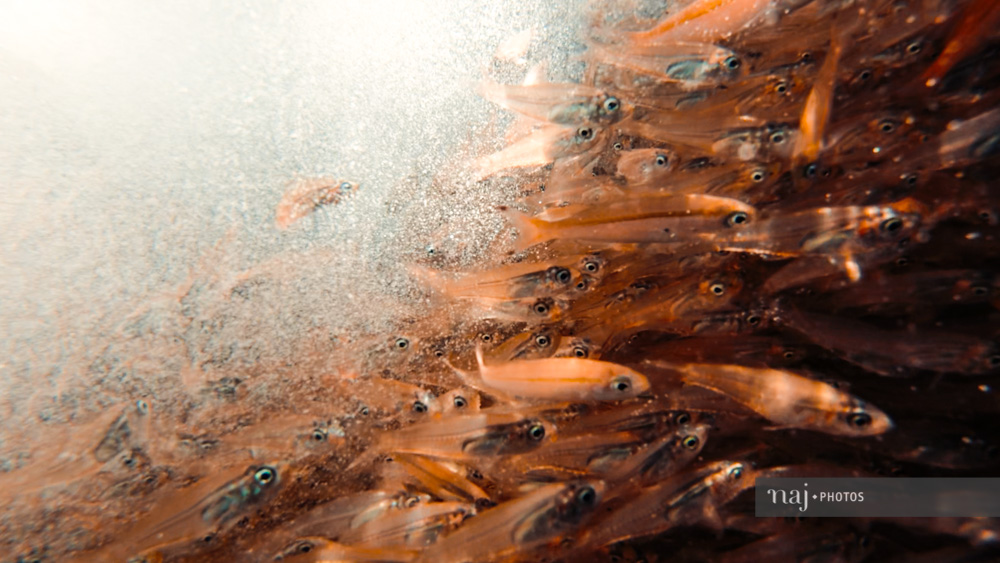
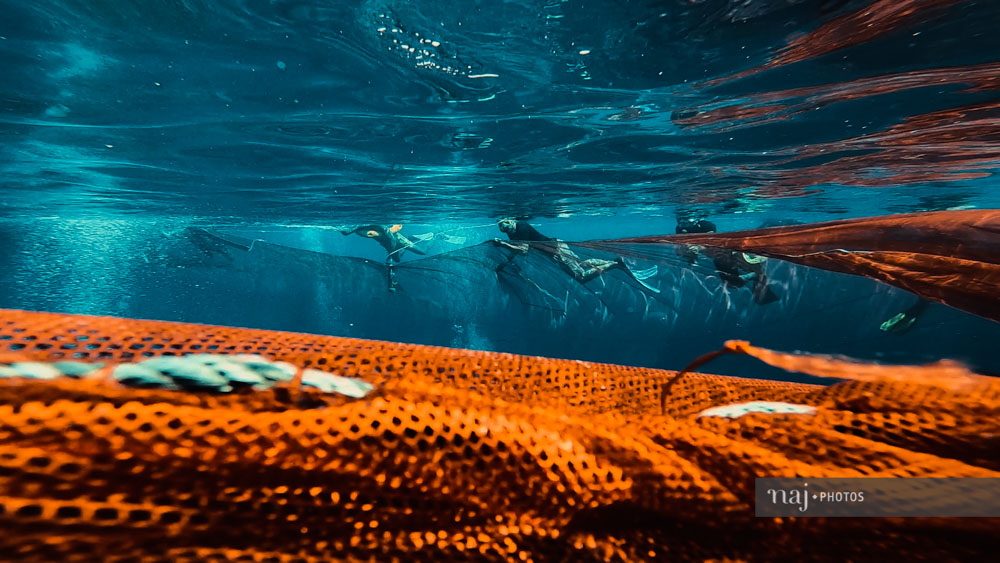
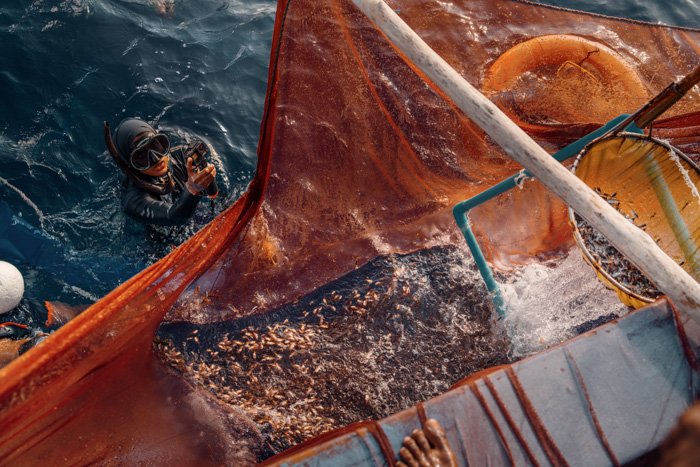
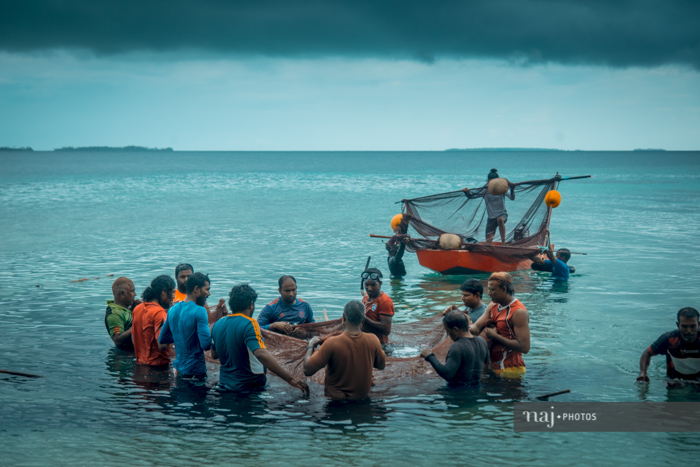
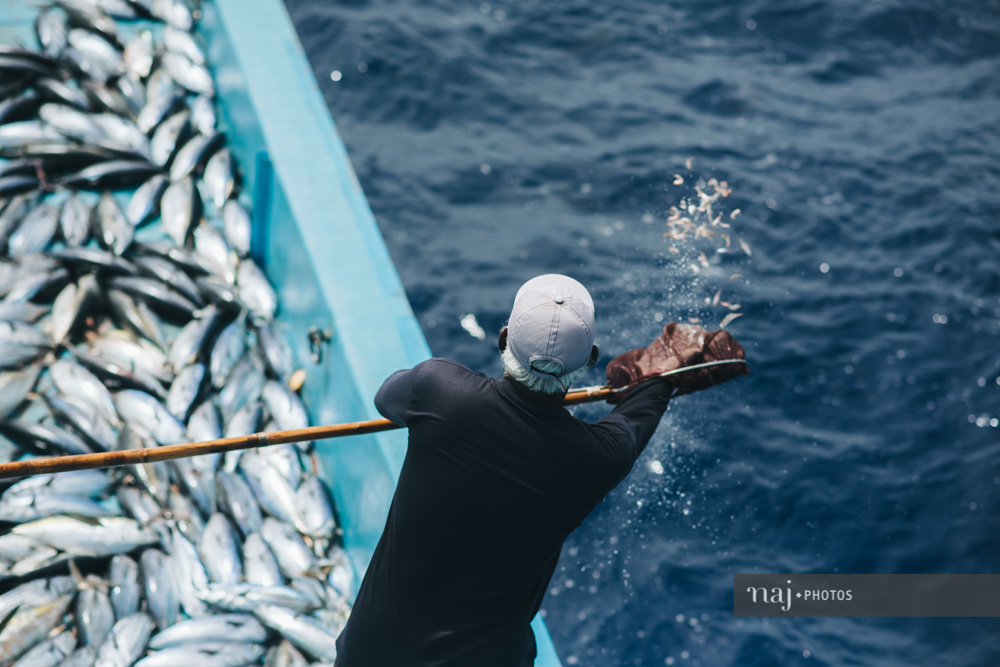
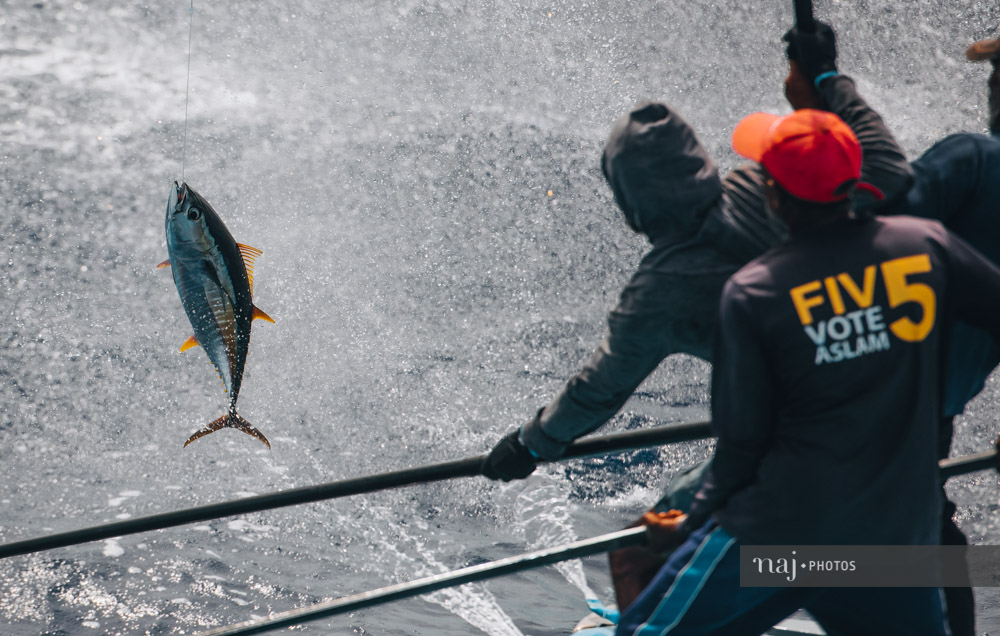
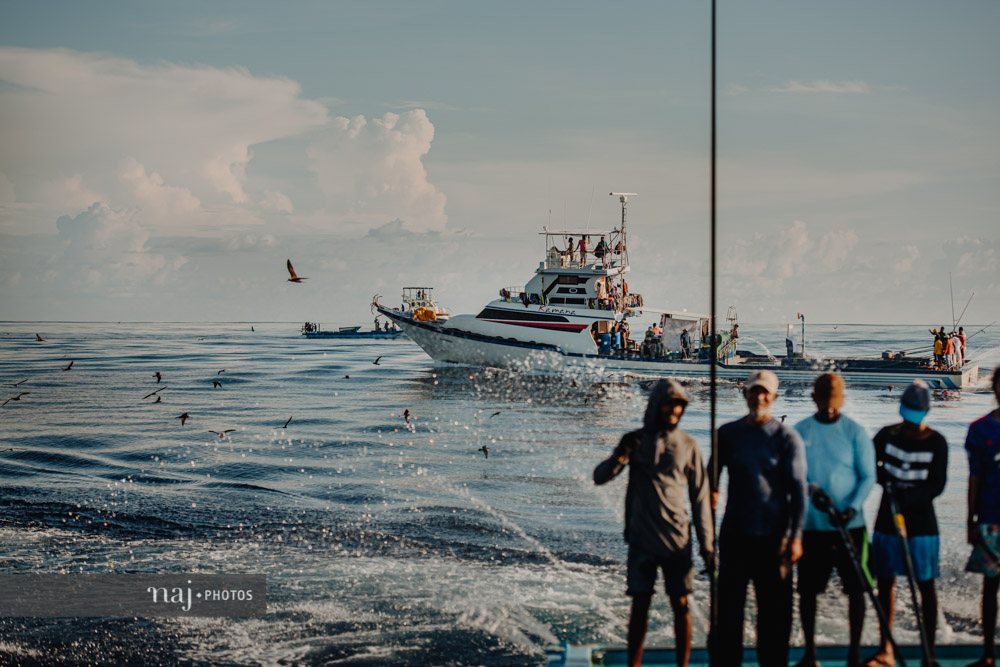
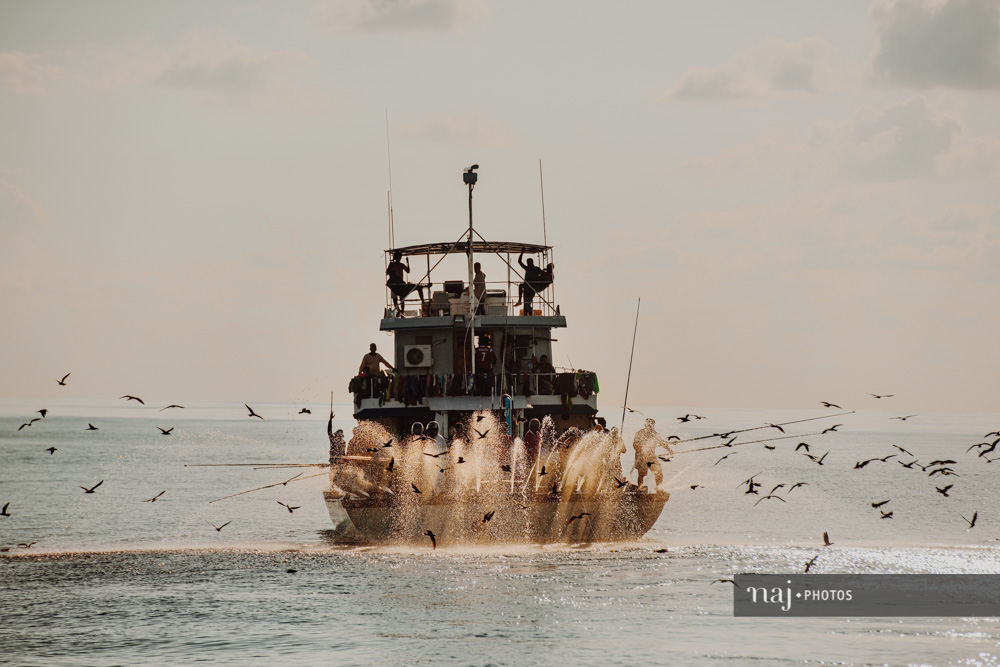
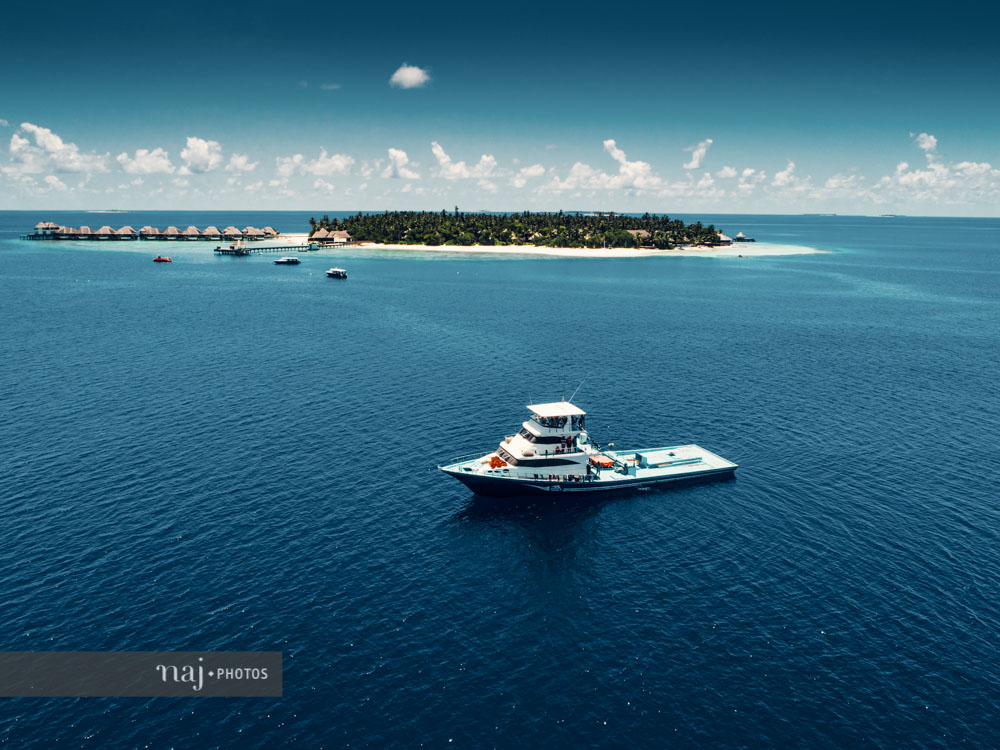
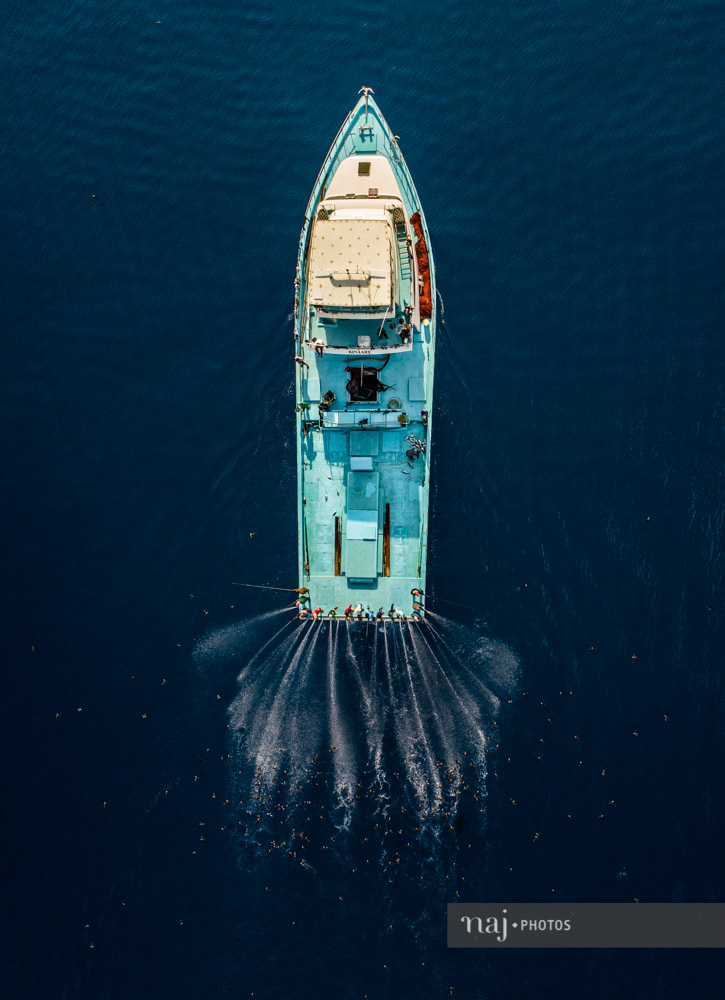
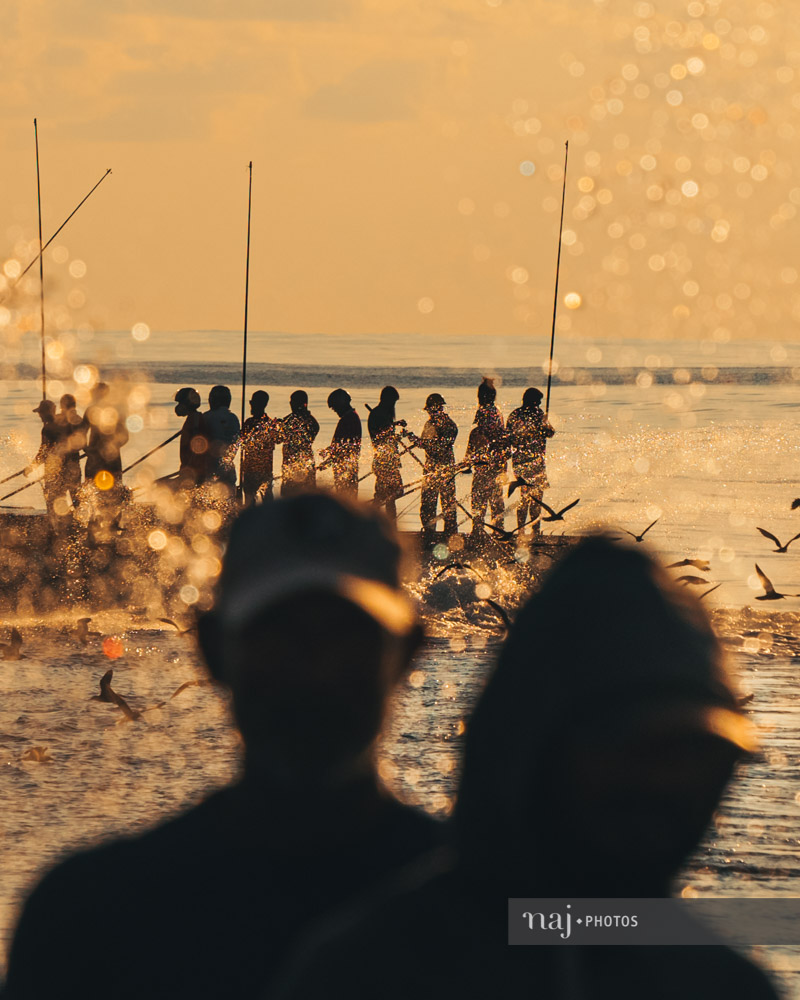
Leave a comment